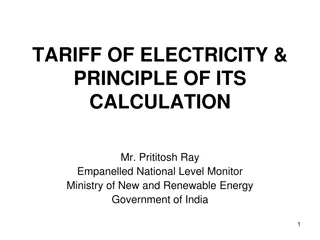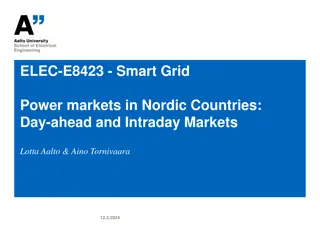Non-Firm Quantities in Electricity Markets
Non-Firm Quantities in electricity markets involve units with non-firm access not being compensated for their non-firm capacity not getting accommodated on the system. The concept of Firm Access Quantity plays a key role in determining compensation levels for units, with differences in implementation between different market structures. Firm Access is crucial for trading sites to calculate unit-level non-firm quantities effectively. Understanding the dynamics of firmness and dispatch volumes is essential in managing non-firm capacities efficiently.
Download Presentation

Please find below an Image/Link to download the presentation.
The content on the website is provided AS IS for your information and personal use only. It may not be sold, licensed, or shared on other websites without obtaining consent from the author.If you encounter any issues during the download, it is possible that the publisher has removed the file from their server.
You are allowed to download the files provided on this website for personal or commercial use, subject to the condition that they are used lawfully. All files are the property of their respective owners.
The content on the website is provided AS IS for your information and personal use only. It may not be sold, licensed, or shared on other websites without obtaining consent from the author.
E N D
Presentation Transcript
Non-Firm Quantities In both the SEM and the I-SEM, a unit with non-firm access does not have the right to be compensated for not being able to have it s non-firm capacity accommodated on the system: A unit s Firm Access Quantity is a value which represents the amount of a Participant s output which can be accommodated on the system based on network reinforcement. If the unit is dispatched down below that level, it is entitled to compensation. The way this is implemented in the I-SEM is different to the SEM, in that it only impacts the balancing and imbalance arrangements: There is no longer a restriction on Participants to gain a market position for their non-firm capacity, they can trade their entire output range above their Firm Access Quantity in the ex-ante markets; Normally Bid Offer Acceptances are settled at the better of the Imbalance Settlement Price or Bid Offer Price. For Dec actions to turn a unit down / off from their market position, this means that the units can be compensated for being turned down they may only need to pay back what they ve stated in the Bid Offer Price, which may only reflect their costs of running, or less through the Imbalance Price, meaning they retain any inframarginal rent they achieved from their ex-ante market revenue; However this treatment is removed for non-firm Dec actions: if a unit traded its Non-Firm capacity but it could not be physically accommodated on the system, it will be treated as an imbalance and they have to pay back for the difference at the Imbalance Settlement Price only; This is implemented through calculating the Non-Firm Accepted Bid Quantity and subtracting it in the Discount Component to ensure that it does not receive a discount, and therefore it is settled only through the Imbalance Component. 2
Non-Firm Quantities Firm Access is a Trading Site concept, therefore there needs to be functionality to assign the Firm Access Quantity to the units under the Trading Site to allow for unit-level non-firm quantities to be calculated: FAQ is divided in a way which is inversely proportional to the Accepted Bid Quantity on each unit: If unit dispatched to PN, fully firm; If unit dispatched below PN, non-firm; The greater the dec volume, the lower the firmness. Unit B Unit C Unit D Unit A PN (A, B, C, D), QD (A, B), FAQ (A, B) QABNF C QABNF D FAQ (C) FAQ (D) QAB C QAB D QD (C) QD (D) 3
Non-Firm Quantities Was any of that volume in non-firm range? qFPN i = 5 MW i = 4 qD i = 3 i = 2 i = 1 + 1 ??????????= ??? ??????? ?????,0 ????????? ??? ????????????,???????????,????????????,?????????????? ? ? ??????????? = ??? ??????? ?????,0 ? ? ????????? ??? ????????????,???????????,????????????,???????????,?????????????,?????????????? 4
Non-Firm Quantities Was any of that volume in non-firm range? qFPN i = 5 MW qFAQ i = 4 qD i = 3 i = 2 i = 1 + 1 ??????????= ??? ??????? ?????,0 ????????? ??? ????????????,???????????,????????????,?????????????? ? ? ??????????? = ??? ??????? ?????,0 ? ? ????????? ??? ????????????,???????????,????????????,???????????,?????????????,?????????????? 5
Non-Firm Quantities Was any of that volume in non-firm range? qFPN i = 5 MW qFAQ i = 4 qD i = 3 i = 2 i = 1 + 1 ??????????= ??? ??????? ?????,0 ????????? ??? ????????????,???????????,????????????,?????????????? ? ? ??????????? = ??? ??????? ?????,0 ? ? ????????? ??? ????????????,???????????,????????????,???????????,?????????????,?????????????? 6























